Top 7 Layer Chicken Breeds: Over 360 Eggs a Year!
- June 21, 2024
- 0 comment
Hello, farmers! I’m excited to talk about some amazing chicken breeds that can lay up to 364 eggs each year. These chickens are not just great at laying eggs; they also have special qualities that might make them the perfect addition to your flock. Whether you have a small backyard coop or a big farm, knowing what makes each breed special will help you choose the right chickens for your needs. Let’s find out more about these top egg layers and see which ones might be right for you!
1. White Leghorn
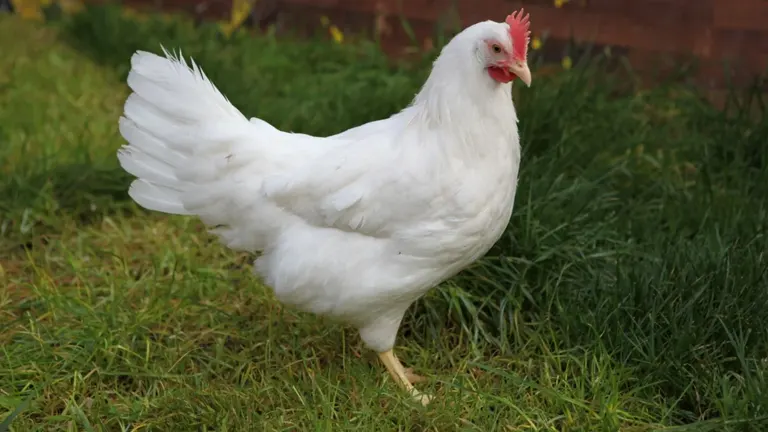
The White Leghorn chicken comes from Leghorn, Italy, and is a top pick for egg farmers because of how many eggs they lay. They look a bit like wild birds and can lay between 320 to 364 large white eggs every year. They live for about 4 to 6 years, which isn’t very long, but they make up for it with their productivity. These chickens are very active and love to search for their own food, especially if they have plenty of space to roam. They’re also tough birds that do well in different weather conditions, making them a great all-around choice for farms.
Care Requirements
- Diet: Require a high-protein diet to support their prolific egg production. Ensure access to a balanced layer feed with at least 16% protein.
- Housing: Prefer spacious coops as they are very active. Adequate space helps prevent stress and feather picking.
- Temperament: Known for being somewhat skittish, Leghorns are better suited for more experienced keepers. They require secure fencing as they are excellent flyers.
2. Rhode Island Red
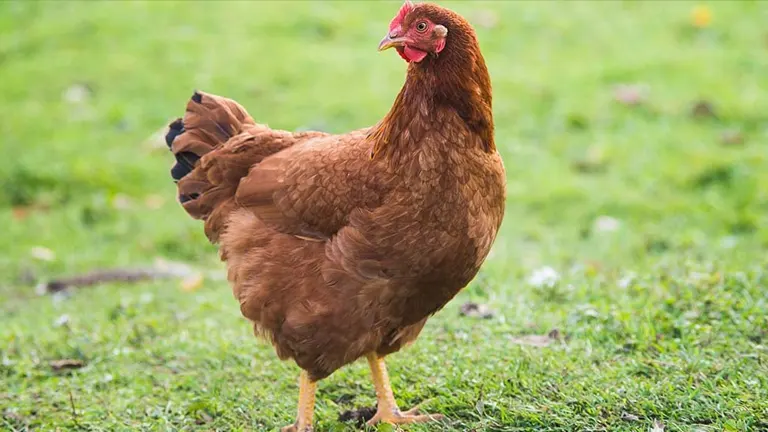
Rhode Island Reds are a versatile breed, excellent for both their meat and the eggs they produce. They’re easily recognized by their rich, chestnut red feathers. These chickens are sturdy and often quite vocal, which makes them good guardians for the flock. Each year, they lay about 200 to 300 brown eggs, making them a popular choice for both rural and urban chicken keepers. They adapt well to different living conditions, thriving in both farm and backyard settings, which adds to their appeal to a range of poultry enthusiasts.
Care Requirements
- Diet: Robust eaters, benefit from a varied diet including grains, greens, and high-quality pellets.
- Housing: Hardy in various climates, but ensure they have shelter from extreme weather. They appreciate areas to dust bathe and perch.
- Temperament: Generally friendly but can be bossy; suitable for mixed flocks but watch for pecking order disputes.
3. Plymouth Rock
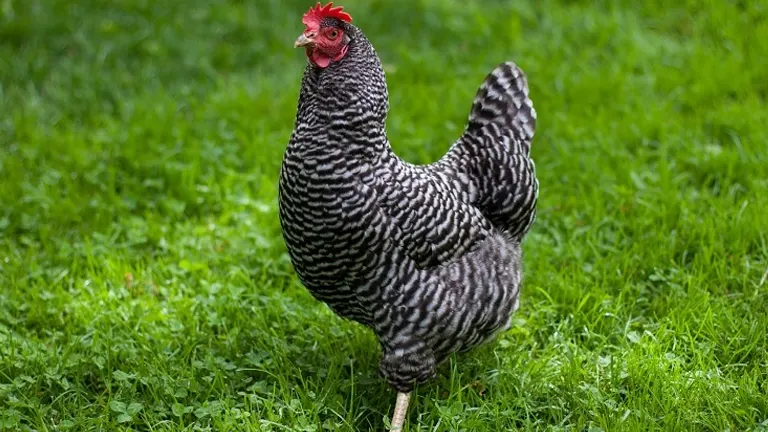
Plymouth Rocks are a fantastic choice for new chicken owners because of their friendly nature and easy care requirements. These chickens are sociable and robust, making them well-suited to family farms or backyard coops. They produce around 200 eggs each year. Known for their deep, full bodied, and moderate size, Plymouth Rocks serve well as dual-purpose birds, providing both eggs and meat efficiently. Their agreeable temperament and consistent productivity make them especially popular among those just starting out with poultry.
Care Requirements
- Diet: Versatile eaters; ensure they get enough nutrients through a mix of pellets, grains, and occasional treats like vegetables.
- Housing: Tolerant of cold, but ensure their coop is well-ventilated, draft-free, and predator-proof.
- Temperament: Very friendly and docile, great for families, and excellent for first-time chicken keepers.
4. Australorp
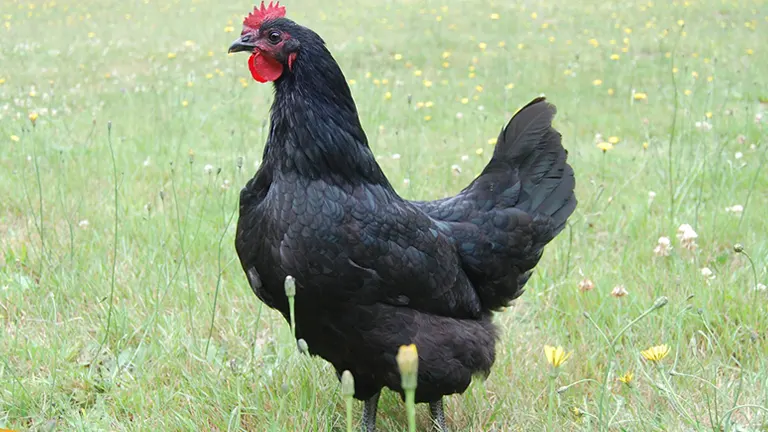
Australorps, developed from Black Orpingtons in Australia, are famous for their remarkable egg-laying abilities. One hen even set a world record by laying 364 eggs in a single year. These chickens start producing eggs as early as 5 months old and are known for their robustness in cooler climates. Over the course of a year, they can lay more than 300 large brown eggs, making them a highly productive breed. Their ability to thrive in various environments and their consistent egg production make Australorps a top choice for those looking to maintain a productive flock.
Care Requirements
- Diet: Requires a diet rich in protein and calcium to maintain their high egg production.
- Housing: Need ample space to roam; can become broody, so provide comfortable nesting boxes.
- Temperament: Calm and friendly, they blend well with other breeds and adapt easily to being handled.
5. Red Star
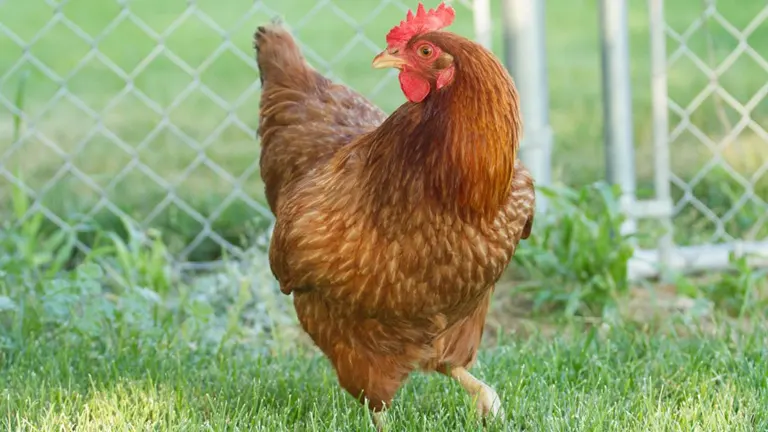
Red Stars, hybrid chickens developed in the 1950s, are engineered to maximize egg production. These versatile birds are known for laying about 300 large brown eggs annually. Their dual-purpose nature, being suitable for both egg and meat production, makes them highly favored in various settings, from small backyard coops to larger commercial operations. Their reliable and prolific laying capabilities ensure they are a popular choice for those seeking a hardworking and efficient breed.
Care Requirements
- Diet: A high-energy diet is needed due to their intense laying patterns. Supplement with calcium for shell quality.
- Housing: Commercial breed, so accustomed to confinement, but thrives when given space.
- Temperament: Very active and intelligent, can be managed in mixed flocks but needs mental stimulation.
6. Orpington
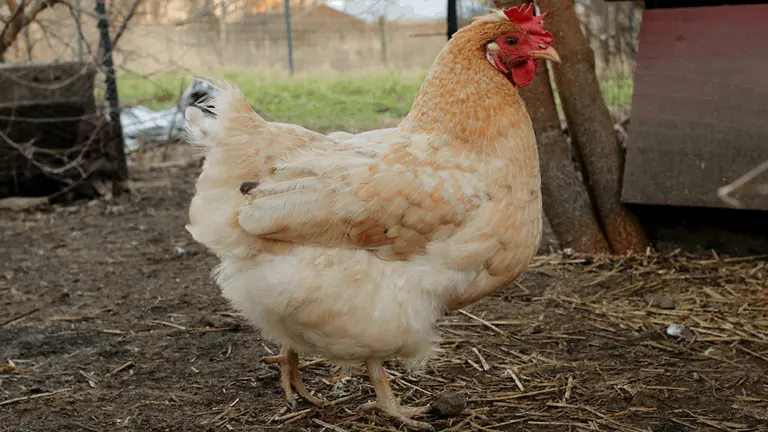
Orpingtons, originating from Britain, are prized for their hefty size and strong health. These birds are reliable producers, laying about 190 large brown eggs each year. They are also valued for their meat, making them an excellent dual-purpose breed. Orpingtons are particularly favored for their adaptability and resilience to common chicken diseases, qualities that make them a top choice for poultry keepers looking for robust and versatile chickens.
Care Requirements
- Diet: Enjoy a variety of foods; balance their intake to avoid obesity, especially in less active environments.
- Housing: Fluffy plumage makes them susceptible to cold dampness; ensure dry, draft-free housing.
- Temperament: Gentle and patient, good with children, and make excellent pets.
7. Sussex
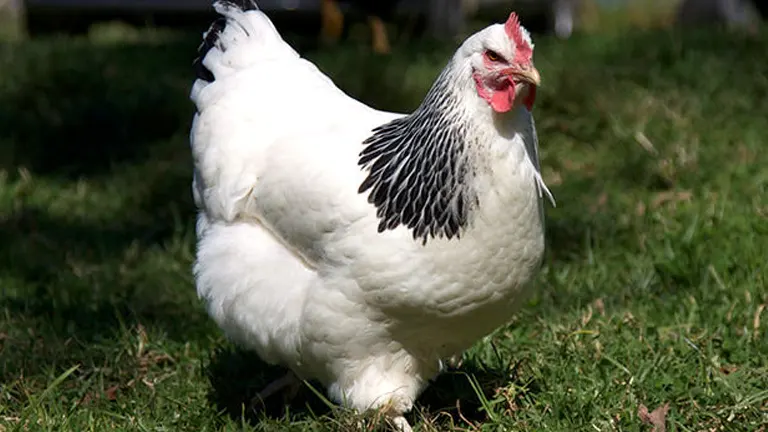
The Sussex chicken, a versatile breed from Britain, excels in multiple roles: as a provider of meat, a prolific egg layer, and even as a competitive show bird. Annually, they lay about 200 to 250 large light brown eggs. Notably, Sussex chickens start laying a bit later than some other breeds but maintain steady egg production throughout the winter months. This characteristic, along with their robust performance in various roles, makes them a favored choice among backyard poultry enthusiasts.
Care Requirements
- Diet: Need a well-rounded diet but watch for overfeeding as they can easily gain weight.
- Housing: Hardy to most climates, but ensure they have shade in summer and warm bedding in winter.
- Temperament: Curious and affable, they can be dominant at times but generally integrate well into diverse flocks.
Comparative Analysis of Top Egg-Laying Chicken Breeds
To help you make an informed decision when choosing the right chicken breed for your needs, here’s a comparative chart summarizing the key traits of each breed discussed. This chart includes information on egg production, climate suitability, space requirements, and general temperament.
| Breed | Egg Production (per year) | Egg Color | Climate Suitability | Space Requirements | Temperament |
|---|---|---|---|---|---|
| White Leghorn | 320-364 | White | Adaptable to various | Active; needs space | Skittish, independent |
| Rhode Island Red | 200-300 | Brown | Hardy in all climates | Moderate | Friendly, protective |
| Plymouth Rock | 200 | Brown | Cold hardy | Moderate | Friendly, docile |
| Australorp | 300+ | Brown | Cold tolerant | Moderate | Calm, friendly |
| Red Star | 300 | Brown | Adaptable | Can be confined | Active, intelligent |
| Orpington | 190 | Brown | Cold hardy | Low; tolerates confinement | Docile, friendly |
| Sussex | 200-250 | Light brown | Adaptable, cold hardy | Moderate | Curious, friendly |
Key Considerations:
- Egg Production: If maximum egg production is your primary goal, White Leghorns and Red Stars are excellent choices due to their high yield.
- Climate Suitability: Consider breeds like Orpington and Australorp if you live in an area with harsh winters, as they are known for their robustness in colder climates.
- Space Requirements: Breeds like the Rhode Island Red and Plymouth Rock are more adaptable to varying space constraints but providing ample space reduces stress and promotes health.
- Temperament: For family-friendly pets, breeds like the Sussex, Orpington, and Plymouth Rock are ideal due to their gentle and friendly nature.
This chart serves as a quick reference to compare the characteristics of each breed side by side, allowing you to consider what is most important for your farm’s conditions and your personal preferences in chicken keeping.
Cost Considerations for Raising Chickens
When planning to add any of the top egg-laying breeds to your flock, understanding the economic aspects is crucial for effective budgeting. Here are the key cost considerations for raising each breed, including initial expenses, feeding, and ongoing maintenance:
1. Initial Costs
- Purchase Price: The cost of each breed can vary depending on the source. Generally, heritage breeds like Sussex or Orpington may cost more than commercial hybrids like Red Stars. Expect to pay anywhere from $3 to $20 per chick.
- Coop and Enclosure: Setting up a safe and comfortable coop is a one-time investment that can range from $200 to over $1,000, depending on size and materials.
2. Feeding Costs
- Feed: Chickens require a balanced diet consisting of layers of pellets, grains, and greens. On average, a chicken eats about 1/4 pound of feed per day. The monthly cost per chicken for high-quality feed can range from $5 to $10, translating to approximately $60 to $120 per year, per bird.
- Supplements: Calcium and grit supplements are relatively inexpensive but essential for egg production and digestion. Expect to spend around $10 to $20 annually per chicken.
3. Maintenance Expenses
- Healthcare: Routine vet checks and vaccinations can help prevent costly health issues. Budgeting around $10 to $30 per chicken per year can cover basic health management.
- Pest and Parasite Control: Products to control mites, lice, and internal parasites are necessary. These can cost around $5 to $15 per year per chicken.
- Miscellaneous: Bedding materials such as straw or wood shavings need regular replacement. Allocate approximately $50 to $100 annually per coop for these supplies.
4. Unexpected Costs
- Emergency Vet Visits: Illness or injury may lead to unexpected vet costs. It’s wise to have a contingency fund of at least $100 to $200 for emergencies.
- Repairs and Upgrades: Over time, your chicken coop and accessories may require repairs or replacements. Setting aside $50 to $150 annually can help manage these expenses without financial strain.
Understanding these costs will help you prepare financially and ensure that your chicken-keeping experience is both rewarding and sustainable. Keep in mind that while some breeds may require higher initial investments, their productivity or low maintenance needs can offset these costs over time.
Conclusion
Each of these chicken breeds brings great benefits, from laying lots of eggs to being good for both eggs and meat. Whether you want to get as many eggs as possible or you’re interested in both eggs and meat, these chickens can fit different farming needs. Think about your local environment, how much space you have, and what you want to achieve with your flock to pick the best breed for you.
FAQs
- How do I protect my chickens from extreme weather conditions?
To protect your chickens from extreme weather, ensure they have a well-insulated coop for cold weather and plenty of shade and ventilation for hot climates. Provide access to clean water at all times and consider using heaters or fans as necessary, but always ensure these devices are safe and appropriate for use around animals. - What is the best way to introduce new chickens into my existing flock?
Introducing new chickens to an existing flock should be done gradually to avoid conflict. Start by keeping them separated but visible to each other for a few days to allow for adjustment. Gradually allow supervised interactions until you see that they can coexist peacefully. Ensure there is enough space to prevent overcrowding and multiple feeding/water stations to reduce competition. - How can I enhance egg production in my chickens?
To enhance egg production, provide your chickens with a balanced diet rich in protein and calcium, maintain a consistent light schedule to simulate longer days, and keep stress levels low by ensuring their environment is safe and comfortable. Regular health checks and keeping parasites under control also contribute to better egg production. - What should I feed my chickens to ensure they are healthy?
Chickens should have a diet that includes high-quality commercial poultry feed, which is formulated to provide all the necessary nutrients. Supplementing with grains, vegetables, and occasional treats like mealworms can provide additional nutrients. Avoid feeding chickens harmful foods such as raw potato peels, avocados, and chocolate. - How can I prevent common health issues in chickens?
Prevent common health issues by keeping the chicken coop clean and dry, practicing good biosecurity measures, and regularly checking for signs of illness or distress. Vaccinations and regular treatments for parasites are also crucial. Ensure fresh water and nutritious feed are always available. - How do I handle a broody hen who doesn’t want to leave her nest?
To handle a broody hen, you can try to break her broodiness by removing her from the nest box and placing her in a separate area with food and water where she can’t create a nest. Some keepers use a ‘broody breaker’ cage, which is a small, elevated cage with a wire bottom. Regular removal from the nest can also discourage this behavior.
We hope this guide helps you choose and raise the perfect egg-laying chickens for your farm! Do you have any tips or stories about your own poultry adventures? Share them in the comments below—we’d love to hear about your experiences and learn together in our farming community. Happy chicken keeping!

David Murray
Forestry AuthorI'm David Murry, a forestry equipment specialist with a focus on chainsaw operation. With over 13 years of experience, I've honed my skills in operating and maintaining a wide range of machinery, from chainsaws to log splitters. My passion for the outdoors and commitment to sustainable forestry drive my work, which emphasizes safety, efficiency, and staying updated with industry advancements. Additionally, I'm dedicated to sharing my expertise and promoting environmental awareness within the forestry community.

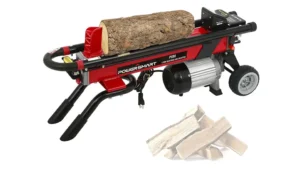











Leave your comment